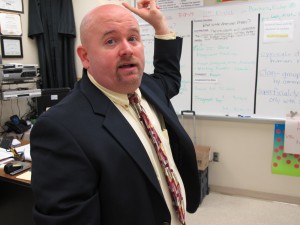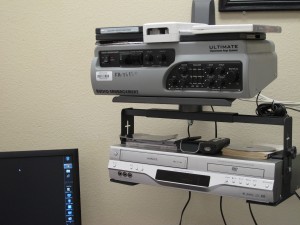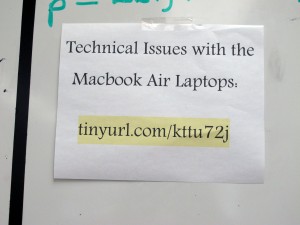New Online Exams Will Also Test School Districts’ Technology

John O'Connor / StateImpact Florida
Thomas McNabb points out the changes made to an Ocoee High School science classroom, part of a $14 million program at seven schools to test the best ways to upgrade school technology.
Ocoee High School just west of Orlando opened less than a decade ago. But technology-wise, the 2,300-student school is already obsolete.
Ocoee is part of $14 million project to outfit seven Orange County schools with fast, wireless Internet and new classroom technology.
The first step was ripping out and replacing miles of fiber optic cable and adding devices teachers could use with their lessons.
Orange County schools’ infrastructure director Thomas McNabb walked through a science classroom, pointing out the changes.
The district added an interactive board at the front of the classroom and and a speaker system to amplify the teacher.
“It may or may not have had wireless, it just depended,” McNabb said. “There were 50 or 70 wireless access points throughout the building. The classroom amplification system was not in play here. All of that was nonexistent at…the end of last school year.”
Orange County schools are preparing for two technology-related deadlines. Florida lawmakers are requiring half of all classroom instruction is delivered digitally by 2015.
But the first deadline comes early next year when Florida students take a new suite of online exams. Millions of U.S. students will join them.
The tests are tied to the new Common Core standards fully adopted by 44 states.
But observers worry websites and networks might melt under a crush of students. They’ve even compared it to the problematic rollout of the national health insurance website.
Many states will use exams from the Partnership for Assessment of Readiness for College and Careers — PARCC — or Smarter Balanced. Those tests were designed by multi-state coalitions with federal money.
Florida and a handful of states have picked their own test.
But education experts are worried something will go wrong when students try to log on to take the exams. Brookings Institution researcher Joshua Bleiberg drew a comparison to the national health insurance website.
“If you assume that they’re not going to do rigorous technical testing – which it doesn’t seem like everyone is going to be on board with doing – then that was one of the problems that HealthCare.gov faced,” Bleiberg said.
Smarter Balanced and PARCC are doing field-testing this spring. More than 6 million students will take prototype exams. The groups have reported few major problems so far.
Many of Florida’s tests are online. But the state will not field test its new Common Core-tied exam before next year.
Fixing any problems with the new online tests could be more challenging than correcting the health insurance website, Bleiberg said..
“There’s…over a thousand school districts in the country,” he said. “And so as big as the problems were for HealthCare.gov, once they encountered them they put together a team, they created a list and they started solving the problems one by one by one.
“There were relatively fewer stakeholders then there would be if there was a catastrophic, nationwide bug in one of these Common Core exams.”

John O'Connor / StateImpact Florida
A classroom amplification system installed in an Ocoee High School science classroom.
Bleiberg said the worst-case scenario would be losing data due to slow load times. That could mean correct answers are scored wrong – and no way to know about the error.
Florida schools are racing to prevent that.
A state Department of Education website tracks the progress. Less than two in five Florida districts meet state goals for high-speed and wireless Internet access. Less than one-quarter has the recommended number of computers.
Hamilton County is a rural district between Jacksonville and Tallahassee. Superintendent Thomas Moffses said getting high-speed Internet to schools is easy. But thick walls and old cabling make wireless classrooms tougher. Moffses formerly worked for the Cisco Network Academy and oversaw about 1,300 teachers teaching technology throughout the South and Caribbean, so he knows his networking.
“I can bring a Ferrari to the front door, but I’m riding a bicycle once I get inside the door,” Moffses said.
Paying for the digital upgrades will be a challenge — particularly since the deadlines are so close.
Florida lawmakers included just $40 million for technology in the state budget. Every district is guaranteed at least $250,000. The long-term goal is to set aside at least $100 million a year in the state budget for new technology.
Florida schools are also keeping an eye on President Barack Obama’s push to equip nearly every school with high-speed wireless Internet by 2018.
A big part of that plan will depend on the E-Rate program, which helps schools and libraries buy high-speed Internet access. The $2.4 billion program is run by the Federal Communications Commission through fees on phone service.
Most Florida districts use E-Rate grants, including Orange and Hamilton County schools.
The FCC is updating the program now. By one estimate, it would cost an additional $800 million per year to get all schools wireless by Obama’s deadline.
Orange County estimates it will cost more than $280 million in state and local money to update district schools. The district is asking voters to renew a tax increase.

John O'Connor / StateImpact Florida
Ocoee High School is testing Macbook Air computers. Students man a help desk which handles some of the tech support.
Moffses estimates the cost of upgrading Internet bandwidth and buying more computers is more than twice the district’s annual capital budget. E-Rate could potentially pick up most of that cost, he said.
Hamilton County has one Internet provider — which means higher prices and slower speeds. About half of Florida’s school districts are in the same situation.
Moffses says his district will be OK for testing next year. But doing so will mean tying up most of the district’s computer labs for up to two months and keeping classes out.
“Do I think we will be OK for testing next year? Yes, I think we will be OK,” Moffses said.
“However, to be OK I’m looking at six, probably eight weeks, of non-stop testing in the labs that I have within my campuses,” he said. “Everytime that I am giving an exam I’m taking away from student instruction.”
Orange County schools said the technology pilot program has convinced them they need to be able to do testing on wireless devices. The school district is trying a variety of devices — Macbook Airs, Chromebooks and more — to see which perform best.
But McNabb said its likely that Orange County schools will roll a cart equipped with a wireless access point and full of laptops into classrooms for testing. Most schools can’t close their computer labs to students for weeks on end, he said.
Ocoee High School was a worst-case scenario last year. Now, principal William Floyd said 1,600 students took tests at the same time this spring, and his information technology staff said they could handle all 2,300 students at the same time.
“Believe me, I was doubtful about testing all these kids at once,” Floyd said. “But these guys, they told me we could do it…and it worked like a charm.”


